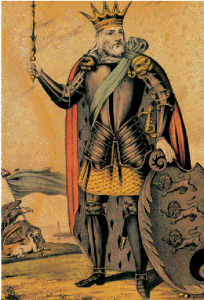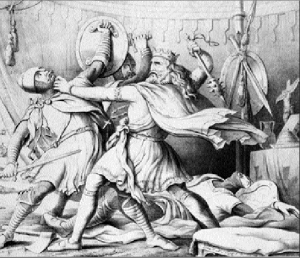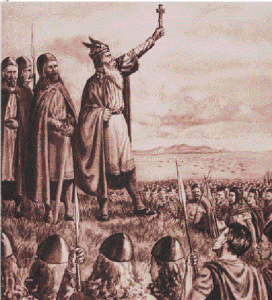Brian Boru and his afterlife
Published in Featured-Archive-Post, Features, Issue 2 (March/April 2014), Volume 22
A nineteenth-century Currier and Ives image of Brian Boru, based on the frontispiece of Geoffrey Keating’s History of Ireland (1723).
The mythologising of Brian Boru began within a generation or two of his death at Clontarf. Cogadh Gáedhel re Gallaibh, an early twelfth-century O’Brienite propagandist tract, first articulated a vision of Brian as belonging to a long line of universal heroic leaders and kings, combining the military prowess of Alexander, the wisdom of Solomon, the fervour and honour of David with the devotion of Moses. Cogadh may have been modelled on the late ninth-century biography of the Saxon king Alfred by Asser, which in turn relied on Einhard’s Life of Charlemagne. This may explain the emphasis on Brian as the builder of roads, and more especially bridges, which was seen as a characteristic of Charlemagne’s rule and symbolised the forging of a state to rival that of the greatest engineers to date, the Romans.
Geoffrey Keating’s Foras Feasa ar Éirinn (c. 1633)
This depiction of Brian as imperial ruler was further promoted by Geoffrey Keating, whose Foras Feasa ar Éirinn (c. 1633) was the first narrative history written in modern Irish. Keating was exercised by accusations of Irish barbarism that had been levelled by English writers in justification of the renewed phase of colonisation since the 1550s. According to this way of thinking, the English were finally bringing civility to a benighted Irish population who had languished in ignorance until the invasion of Henry II in 1172, and whose savage but seductive ways had unfortunately corrupted the earlier colonists, or Old English. Keating, who was himself of Old English stock, wrote a history that set out to show that the Irish had been civilised even before the arrival of Christianity in the fifth century, and well in advance of the Britons and Anglo-Saxons of the neighbouring island. To be sure, Ireland had suffered from the depredations of the Vikings in the ninth and tenth centuries, to the extent that its reputation for sanctity and learning (‘the Island of Saints and Scholars’) had been threatened. Only the emergence of Brian had turned back the tide: as king he had ordered the restoration of damaged churches and the building of many new ones; schools were erected ‘for the teaching of letters and sciences’, with scholarships for those who needed them; and he restored the land and property of those who had been plundered by the Vikings.

Samuel Watson, ‘Brian Boroimhe at the battle of Clontarf’ (1867). Sylvester O’Halloran’s General history of Ireland (1778) has Brian kill Bródar and two other Vikings who entered his tent before succumbing to the dastardly blow of a fourth. (NLI)
For mythologising historians there was one notable blemish on this record, however, and that was the unpalatable fact that Brian had come to the high-kingship by deposing Malachy (Máel Sechnaill) of the Southern Uí Néill dynasty, the hereditary high-kings. Keating’s response was to contrast Brian’s dynamism with Malachy’s lapse into a life of ‘luxury and ease, a line of action that was useless for the defence of Ireland at that juncture’. According to Keating, Brian deserved the high-kingship ‘by the strength and bravery of his feats of valour and championship, driving the . . . foreigner out of Ireland’, and for this reason he had the support of ‘the majority of the nobles of Ireland’.
Keating’s history circulated widely in manuscript in both English and Irish throughout the seventeenth and eighteenth centuries, and ensured the cementing of Brian’s position as pre-eminent Irish monarch and statesman. When an English translation of Foras Feasa ar Éirinn was published in 1723, it was inevitable that the frontispiece should be of Brian in regal pose and heavily armoured. The book was dedicated by its translator, Dermod O’Connor, to the third earl of Inchiquin, William O’Brien, in recognition of the ‘heroic exploits’ of his royal ancestors. Such eulogies of the illustrious pre-colonial heritage of Gaelic families like the O’Briens of Thomond who had converted to the Church of Ireland were designed both to emphasise their rootedness in Ireland and to distance them from the stereotype of the barbarous Gael, the stigma of which endured.

P. O’Byrne, ‘Brian Boru, king of Ireland (941–1014)’ (1910). The ‘Dublin Annals of Innisfallen’ recounted a version of the battle preparations that stressed Brian’s patriotic vigour as he circulated among the troops, brandishing a crucifix and urging them to stand firm against the foreigners. Thus the battle was presented as a last-ditch struggle between Christianity and paganism. (NLI)
Hugh MacCurtin’s Brief discourse in vindication of the antiquity of Ireland (1717)
The Gaelic poet and antiquary Hugh MacCurtin (Aodh ‘Buí’ Mac Cruitín), whose family had been hereditary seanchaithe or chroniclers to the O’Briens of Thomond since the fourteenth century, also dedicated his Brief discourse in vindication of the antiquity of Ireland (1717) to Inchiquin. This defence of Irish history as a record of noble deeds, sanctity and learning until the coming of the English in the twelfth century emphasised Brian as the military commander who had wrested Munster ‘out of the Hands of those Barbarous, Inhuman Tyrants the Danes’, before going on to banish them from the whole kingdom. MacCurtin’s Brian was pre-eminently a warrior rather than an architect of civil governance; he and his troops engaged in continual warfare with the Viking enemy, ‘embruing their Swords in the blood of their Opposers’. To heighten the melodrama, MacCurtin invented high-flown speeches for Brian and Malachy in a confrontation at Tara over the high-kingship. Summoning Malachy to his encampment, Brian addressed him thus:
‘You know, Sir, how I have reduc’d the Danes . . . and releas’d the freedom of the Subjects altogether by the blood of my own Kindred
. . . [while] you sat down and saw the blood of the Natives daily spilt . . . their Lands . . . possess’d by their Enemies; their Churches . . . in Ashes . . . I am come to possess and defend the Crown of our great Ancestors.’
Whereupon Malachy, after a long silence, resigned his title, calling Brian ‘You mighty Defender of the Irish Nation, you invincible Champion of our Country, and you most Renowned Hero of this Age!’
It must have been a disappointment to writers such as MacCurtin that the author of Cogadh, the main source at that time for the pinnacle of Brian’s career, the Battle of Clontarf, insisted that he did not lead his army, owing to his great age. Most of the accounts, from Keating’s Foras Feasa ar Éirinn onward, had Brian taking no part and retiring to his tent to pray for victory, until attacked and killed by the Viking commander Bródar. From the 1760s, however, there were attempts to boost Brian’s role at Clontarf to one befitting his reputation as the premier slayer of Vikings. Ferdinand Warner, the only English historian of that century to write a full narrative History of Ireland (1763), had Brian marching at the head of the army as it proceeded to Clontarf, before relinquishing command to his son: ‘Though his great age had unstrung or palsied every nerve, yet the din of arms, to which he had been trained up from his infancy, and in which he had shone with supreme lustre, had warmed the almost frozen blood in his veins; and he would march at the head of his confederate army’.
Sylvester O’Halloran’s General history of Ireland (1778)
It was Sylvester O’Halloran, purveyor of a romantic and colourful version of the Irish past, who provided the most vibrant account of Clontarf and of Brian’s role, in his General history of Ireland (1778). Here he may have drawn on the so-called ‘Dublin Annals of Innisfallen’, which were assembled for John O’Brien, Catholic bishop of Cloyne and Ross from 1748 to 1769, and designed to appeal to O’Brien ancestral pride. The ‘Dublin Annals’ recounted a version of the battle preparations that stressed Brian’s patriotic vigour as he circulated among the troops brandishing a crucifix and urging them to stand firm against the foreigners. Thus the battle was presented as a last-ditch struggle between Christianity and paganism. O’Halloran elaborated on this image of Brian, perhaps influenced also by the well-known story of the Emperor Constantine, the first Christian Roman emperor, who won a great battle against his pagan rival Maxentius at the Milvian Bridge outside Rome in AD 312 after, it was said, he had his troops paint the Christian cross on their shields. Following the example of MacCurtin, O’Halloran invented a powerful speech for Brian to deliver as he rode through the ranks of the ‘imperial army’, exhorting them to ‘do their duty as soldiers and Christians, in the cause of their religion and their country’, and reminding them that their pagan foe had fixed ‘on the very day on which Christ was crucified, to destroy the country of his greatest votaries; but that God, whose cause you are to fight this day, will be present with you, and deliver his enemies into your hands’. Not content to have Brian then leave the battlefield without using his sword, O’Halloran has him kill Bródar and two other Vikings who entered his tent before succumbing to the dastardly blow of a fourth.
‘Preposterous’ as this narrative was, according to Seán Duffy, the most recent historian of the battle, O’Halloran’s account of Brian’s role proved enormously influential in the following century, when his works were reissued a number of times. The raft of patriotic popular histories that were produced, mainly from the mid-nineteenth century, all bear the imprint of O’Halloran’s grandiose vision of Brian Boru at Clontarf. A.M. Sullivan’s The story of Ireland (1867) epitomised this trend, but also updated the vision by referring to the battle as a defence of ‘Faith and Fatherland’. He also enhanced the rhetorical impact of that famous speech by having Brian, ‘his white hair floating in the wind’, urge the troops to ‘remember that on this day Christ died for us, on the Mount of Calvary’, adding that the soldiers in response were moved to tears as well as to ‘the utmost pitch of enthusiasm and resolution’. It is significant that Sullivan, along with other historians of the time, found implausible O’Halloran’s claim that the aged Brian had managed to kill three Vikings before his own death and yet were happy to adopt—and, indeed, individually add to—his address to the troops before the battle.
Christian Brothers’ school textbooks
The image of Brian Boru that had emerged at the end of the eighteenth century continued to work its magic in school textbooks of the late nineteenth and early twentieth centuries, notably those of the Christian Brothers. Indeed, one of those brothers, J.M. O’Brien, author of, among other works, The Irish history reader (1905), claimed the victor of Clontarf as his illustrious ancestor. Famed for his performance of patriotic songs and stories at community gatherings, in 1923 Br O’Brien was struck down by a heart attack as he recited Brian’s address to the army at a gathering in Kilcock, Co. Kildare. Clearly, the largely invented version of Brian Boru, complete with patriotic speeches, continued to exert its hold on popular nationalism well into the modern era. It is also noteworthy that all the Irish historians featured here had strong Munster connections: O’Brienite myth-making has indeed cast a long shadow.
Clare O’Halloran lectures in history at University College Cork.
Read More: Gormlaith—the femme fatale of Clontarf?
Further reading
S. Duffy, Brian Boru and the Battle of Clontarf (Dublin, 2013).
M. Ní Mhaonaigh, ‘Tales of three Gormlaiths in medieval Irish literature’, Ériu 52 (2002).
C. O’Halloran, ‘The triumph of “virtuous liberty”: representations of the Vikings and Brian Boru in eighteenth-century histories’, Eighteenth-Century Ireland 22 (2007).


















